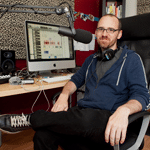Each time we put our mark on the land, we accept the ‘terms and conditions’ of the Earth, which state plainly that what we build will not last forever. This idea is well represented below in the contrast between the nascent design work happening at Freshkills Park and the practically post-apocalyptic slog of Detroit. Wherever they fall on the spectrum, here are six things we guarantee will leave you thinking about the sustainability of our cities. Check them out below.
1. 99% Invisible
Addicted, 270 days and counting. This radio show by Roman Mars is a delightful slice of urban exploration and thoughtful storytelling. A wunderkind who was accepted into college at age 15, Mars is interested in anything related to design, from “queue theory” to how we architecturally segregate our cities. It’s not related to the Occupy movement, except in that it too hopes to draw attention to the 99 percent of our world we tend not to notice. The 20-minute episodes air weekly on KALW San Francisco and are available as free downloads.

The podcast recently peaked at #8 in the iTunes rankings for all podcasts and #1 in both the Arts and Design categories.
2. Hue
One bulb and every color of the rainbow. More specifically, any color on the spectrum. That’s the promise of Hue, by Philips, a wireless LED bulb that can be screwed into a typical socket and controlled from a smart phone or tablet. Forgot to turn off the lights? Do it on your way to work. A three-bulb starter pack runs at $199.95, but that’s three bulbs and the “bridge,” the connector between the bulbs and the app required to operate them. With an expected lifespan of 15 years, we say that’s a good investment.

The Hue starter pack, three bulbs and the “bridge” that allows them to sync with your computer or mobile device.

Hue allows users to wirelessly control the colors and brightness levels of individual bulbs throughout a home or office space.
3. Ecological Urbanism App
Our cities are evolving to be more ecologically supportive of the land they increasingly blanket, and case studies from around the globe are a developer’s best friend. Ideas that work across an ocean could save American cities, yet even superheroes can’t be everywhere at once. Unless, of course, they have this app from the Harvard Graduate School of Design, the next logical iteration of its eponymous book series. Download it for free from the iTunes App Store. (And while you’re in the App Store, there’s this magazine called gb&d…)

Download the app from iTunes here: https://itunes.apple.com/us/app/ecological-urbanism/id556595863?mt=8
4. Land Art at Freshkills Park
The Land Art Generator Initiative’s 2012 competition involved a site within Freshkills Park, a 2,200-acre former landfill now maintained by New York City’s parks and recreation department. Proposals for art that also generated clean energy came from around the world, visions of giant screens laced with piezoelectric wires (the winner), cornucopia-like wind farms, even 99 red balloons, which unlike those in the song would be 50 feet tall and lined with transparent solar cells. Sifting through them is like watching a movie trailer for the future.

Scene-Sensor, by Atlanta’s James Murray and Shota Vashakmadze, won the Land Art Generator Initiative’s 2012 competition.
5. Detropia
“We can experiment here,” says street artist Steve Coy in this documentary film, a rattling investigation into the history and future of Detroit, an American city that for years has seemed to be in the twilight of its existence, fighting extinction. Directed by Rachel Grady and Heidi Ewing and nominated for the Grand Jury Prize at the 2012 Sundance Film Festival, Detropia documents a city that will not go quietly into the night and raises questions about the future of the built environments that we consider bulletproof today.

A still from the film by Rachel Grady and Heidi Ewing, which tells the story of the auto industry’s decline in Detroit and the city’s response to it.

The inspiration for the film’s title was this former “auto parts” sign, which was made to read, “utopia.”

Michigan Central Station, the passenger depot for Amtrak until 1988, was built in 1913 and at the time was the tallest train station in the world. Now it is gutted and has become a symbol of Detroit’s struggle.
6. TrafficCOM
Not a single aspect of city planning goes unaffected by traffic patterns, but fortunately those patterns just got a lot easier to map. Developed by urban planner Aurash Khawarzad and industrial designer Ted Ullrich, TrafficCOM lets anyone with $140 measure the number of cars and bikes on any given street. The counter is small and easy to use, and the data can be uploaded to a computer with a USB cable in minutes. By far the simplest and cheapest counter on the market, city planners should never leave home without it.

TrafficCOM in deployment. The new system is one of the simplest and most affordable methods for collecting data about traffic patterns.

TrafficCOM can be connected to any computer via USB. User-friendly software makes data uploads quick and easy.
Check out more Editor’s Picks here!




